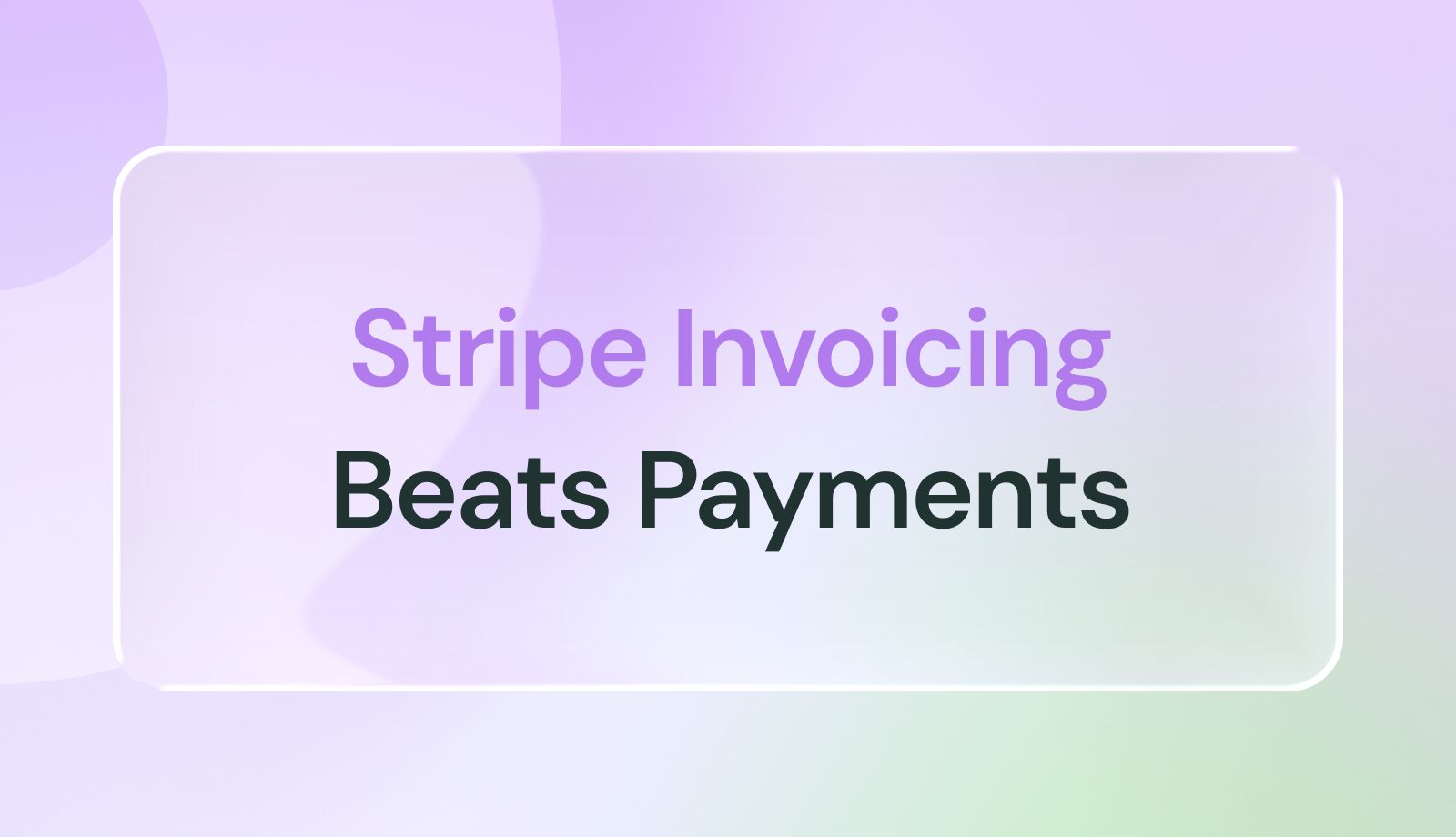Stripe Invoicing vs. Stripe Payments: 7 Reasons Invoices Win
24 September

Ready to automate your sales tax?
Sign up for free
Are you torn between Stripe Payments and Stripe Invoicing? Are you confused if they’re the same or which one is better?
Stripe Payments and Stripe Invoicing both accept payments. However, they serve different purposes and picking the wrong one can cost you time and money.
This guide untangles the differences between the two and shows why Stripe Invoicing could be a smarter and more scalable choice.
What Is Stripe Payments?
Stripe Payments refer to Stripe’s suite of payment processing tools and APIs. This includes everything from hosted checkout pages and payment links to embedded payment forms and advanced payment intents. It also provides tools for fraud prevention, security, and reporting.
Stripe Payments caters to all your payment needs in one platform, offering multiple options for customer interfaces, including API-only, third-party integration, embeddable UI toolkit, prebuilt payment forms, payment links, or in-person payments. Stripe Invoicing is a separate module built on top of Stripe Payments and not part of the core Payments interface.
It also manages online payments, unified commerce, recurring payments, and more. For payments, it accepts cards, wallets, bank debits, buy-now-pay-later, cash-based vouchers, and 135+ currencies through a single API or hosted checkout page.
Payment links are related to specific products and prices but not tied to a customer unless you attach a customer ID. You can create a payment link to an e-book, course, or a product you plan to sell before you know who the customers will be.
Payment links are reusable. You can send the same payment link to all customers and receive multiple payments.
Pros
- Quick to set up and use
- Ideal for instant purchases
- Great for embedded checkout flows
- Seamless experience for buyers
Cons
- Does not generate a tax-compliant invoice (with invoice number, terms, and more)
- No automated reminders or late payment handling
- Limited for B2B or custom payment terms
What Is Stripe Invoicing?
Stripe Invoicing is a feature designed to bill customers by sending a professional invoice, often via email or downloadable PDF, with a secure payment link. Invoices are directly related to specific customers that you typically know about.
Each invoice provides an optimized experience across mobile, tablet, and desktop with a responsive design that also offers Apple Pay and Google Pay. Once the invoice link is paid, the link is not reusable.
Invoicing is part of Stripe Billing and is ideal for businesses needing:
- Official invoicing records
- Flexible payment terms (e.g., net 30, partial payments)
- Automated follow-ups and receipts
Invoices are unique. You can customize the content and branding of your invoices. Stripe automatically generates invoice numbers to help track and reconcile invoices. It also allows you to store and render your tax IDs.
Stripe Invoicing includes shipping addresses, contact information, descriptions of goods or services, tax breakdowns, discounts, and memos. It is optimized for both B2B and B2C invoicing workflows.
Pros
- Generates official invoices with line items and taxes
- Supports flexible due dates, partial payments, and discounts
- Sends automatic reminders and retries failed payments
- Professional appearance with branding options
Cons
- Customers can’t change the total invoice amount themselves and must ask the merchant to enable or issue a partial-payment option
File faster, smarter, and on time with Kintsugi.
Stripe Payments vs. Stripe Invoicing
Stripe Payments is a general-purpose payment processing system that accepts various payment methods.
Stripe Invoicing is designed to create and send customer invoices with payment links. It is built on top of Stripe Payments to leverage payment processing capabilities and facilitate invoice-based transactions.
| Comparison Criteria | Stripe Payments | Stripe Invoicing |
|---|---|---|
| Goal | Instant payment collection | Structured billing and collection |
| Customer flow | Immediate checkout | Invoice is sent and customer pays later |
| Line items | Optional | Required and itemized |
| Reminders & retries | Manual | Automatic |
| Payment recovery | Checkout and Payment Links don’t retry by default, but developers can add custom code to follow-up on failed or abandoned pay-now transactions. | Sends automatic reminders and retries failed payments on a schedule you set. |
| Compliance and chargebacks | Instant payment but lacks official invoice number and audit trail. Document is inadequate when customers dispute the charge. | Invoices store line-item taxes, terms, and acknowledgments, giving you a documented audit trail. This also reduces chargeback losses and keeps you on the right side of VAT or sales tax rules. |
| Use cases | Ideal for one-time purchases, donations, and when customers are ready to pay for the product. | Ideal when you need formal invoices for subscription cycles or milestone billing. |
| Flexibility | Supports a wide range of payment methods, including credit cards, digital wallets, and local payment options. | Allows flexible billing models, automates invoice delivery, and customized payment terms (payment plans, partial payments, discounts, or late fees). |
| Link | Reusable | Not Reusable (Every invoice link is unique. You can resend the same link until it's paid, but it can't be repurposed for a different customer or amount) |
| Branding | Basic | Customizable |
| Best for | Quick pay, instant checkouts, e-commerce, and donations | Freelancers, B2B sales, project billing, recurring invoices |
To make it simpler, Stripe Payments is best for standard cart checkout and pay-now buttons. However, if you want to quote, negotiate, and bill later, Stripe Invoicing is a better choice.
Advantages of Using Stripe Invoicing
Ready to level up from simple “pay-now” buttons? This section unpacks the key advantages of Stripe Invoicing over basic Stripe Payments, showing how professional invoices, built-in reminders, and flexible terms can boost cash flow and cut admin work.
1. Professional, Branded Billing Documents
Stripe Invoicing automatically generates polished PDFs and styled emails with your logo, brand colors, and contact details. This elevates your customer’s perception of your business without requiring design work or extra tools. A sleek invoice instills confidence and makes larger payments feel safer.
Visual consistency also helps distinguish you from competitors still sending plain receipts. Every invoice becomes a mini–brand touchpoint that reinforces trust. Over time, that trust can translate into higher-order values and repeat business.
2. Built-In Reminders & Automatic Retries
Late payments drain cash flow, and manual follow-ups drain time. Stripe Invoicing can email gentle reminders before and after the due date and automatically retry failed cards on a smart schedule. You stay top-of-mind without lifting a finger.
Because retries use Stripe’s machine-learning “smart attempts,” each try happens at the optimal time for a successful authorization. That means more money is collected without angry emails. Over weeks and months, recovered revenue can be significant.
3. Itemized Taxes and Discounts
Stripe Invoicing lets you list each product, tax line, and discount. Invoices are more detailed than the receipts you will receive from Stripe Payments.
For sellers, this is critical because miscalculating taxes can trigger audits. Without invoices, you’re left reconciling individual transactions and hunting for missing tax info.
4. Flexible Payment Terms
Not every customer can pay immediately. Stripe Invoicing supports net 30, net 60, partial payments, and even late-fee rules, all configurable in a few clicks. That flexibility can close deals that a pay-now link would lose.
B2B buyers often require purchase-order processes or internal approvals. Offering terms meets those requirements while still automating collection. You get paid on a clear timeline and customers get breathing room.
5. Accounts-Receivable Reporting
Stripe provides a real-time dashboard showing invoices sent, viewed, paid, or overdue. Status filters and CSV exports plug directly into QuickBooks and other accounting tools. You can spot cash-flow gaps before they happen.
For founders juggling multiple hats, having the data in one place cuts decision-making time. No more chasing down who owes what and when. Clear reporting also helps when you need financing or investors ask for metrics.
6. Integrated Quotes-to-Invoice Workflow
Stripe Invoicing lets you turn an approved quote into a billable invoice with one click. This eliminates copy-paste errors and keeps sales and finance teams in sync. Faster hand-offs mean faster payments.
Clients appreciate a seamless process from proposal to payment because it shows professionalism. Internally, you skip redundant data entry and reduce mistakes. Closing the loop quickly boosts both revenue velocity and customer satisfaction.
7. Built-in Audit Trail & Dispute Protection
Every Stripe invoice lists products, quantities, discounts, taxes, and payment terms. Additionally, each invoice logs every action from creation, send time, view time, and payment attempts, creating proof in case of chargebacks or tax inquiries. Stripe Payments lacks that chronological record, so disputes are harder to defend.
When a customer pays, Stripe logs that they viewed the invoice and agreed to the terms, due dates, and other specifics listed. In a chargeback, that itemized record shows the card issuer exactly what was sold and that the buyer consented, which you don’t get from a basic payment link or one-click wallet checkout.
Kintsugi Integrates With Stripe Invoicing
Kintsugi, a trusted sales tax automation provider, works with transactions processed via Stripe Invoices only. Kintsugi does not work with Stripe Payments because key information necessary to calculate sales tax accurately, including shipping addresses, product descriptions, and quantity of sold items are optional. Thus, the data from Stripe Payments could sometimes be incomplete.
Invoices always contain structured line-item and tax details that Kintsugi relies on for guaranteed tax accuracy. Kintsugi is dedicated to helping its clients with sales tax compliance and doesn’t settle with approximate tax rates. Thus, Stripe Invoicing is the best partner.

Catherine Armecin Martin
Cath is a content writer for marketing at Kintsugi. She graduated with a degree in Computer Science at the University of the Philippines Cebu. Her passion for writing paved the way for a career shift from writing codes to copywriting. She also writes web content and news articles. She has contributed to several online media publishing, including International Business Times, The List, and Game Rant. Cath is an avid reader and writer committed to continuous learning and personal growth. She views herself as a work in progress, always open to new insights and experiences. Passionate about sharing knowledge, she strives to inform, inspire, and contribute positively to those around her.
Ready to automate
your sales tax?
2261 Market St,
Suite 5931
San Francisco, CA 94114
Resources
US State Sales Tax GuidesCanada Province Sales Tax GuidesUS City Sales Tax GuidesFree Exposure (Nexus) StudySecurity & PrivacyBlogAPI ReferenceKintsugi Status2261 Market St,
Suite 5931
San Francisco, CA 94114

